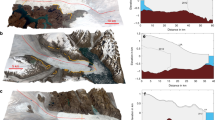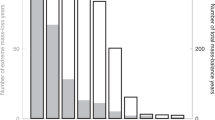Abstract
Glacier mass loss is a key contributor to sea-level change1,2, slope instability in high-mountain regions3,4 and the changing seasonality and volume of river flow5,6,7. Understanding the causes, mechanisms and time scales of glacier change is therefore paramount to identifying successful strategies for mitigation and adaptation. Here, we use temperature and precipitation fields from the Coupled Model Intercomparison Project Phase 5 output to force a glacier evolution model, quantifying mass responses to future climatic change. We find that contemporary glacier mass is in disequilibrium with the current climate, and 36 ± 8% mass loss is already committed in response to past greenhouse gas emissions. Consequently, mitigating future emissions will have only very limited influence on glacier mass change in the twenty-first century. No significant differences between 1.5 and 2 K warming scenarios are detectable in the sea-level contribution of glaciers accumulated within the twenty-first century. In the long-term, however, mitigation will exert strong control, suggesting that ambitious measures are necessary for the long-term preservation of glaciers.
This is a preview of subscription content, access via your institution
Access options
Access Nature and 54 other Nature Portfolio journals
Get Nature+, our best-value online-access subscription
$29.99 / 30 days
cancel any time
Subscribe to this journal
Receive 12 print issues and online access
$209.00 per year
only $17.42 per issue
Buy this article
- Purchase on Springer Link
- Instant access to full article PDF
Prices may be subject to local taxes which are calculated during checkout



Similar content being viewed by others
References
Gregory, J. M. et al. Twentieth-century global-mean sea-level rise: is the whole greater than the sum of the parts? J. Clim. 26, 4476–4499 (2013).
Church, J. et al. in Climate Change 2013: The Physical Science Basis (eds Stocker, T. et al.) 1137–1216 (IPCC, Cambridge Univ. Press, 2014).
Richardson, S. D. & Reynolds, J. M. An overview of glacial hazards in the Himalayas. Quat. Int. 65, 31–47 (2000).
Huggel, C., Clague, J. J. & Korup, O. Is climate change responsible for changing landslide activity in high mountains? Earth Surf. Process. Landf. 37, 77–91 (2012).
Jansson, P., Hock, R. & Schneider, T. The concept of glacier storage: a review. J. Hydrol. 282, 116–129 (2003).
Immerzeel, W. W., van Beek, L. P. H. & Bierkens, M. F. P. Climate change will affect the Asian water towers. Science 328, 1382–1385 (2010).
Huss, M. Present and future contribution of glacier storage change to runoff from macroscale drainage basins in Europe. Water Resour. Res. 47, W07511 (2011).
Egholm, D., Nielsen, S., Pedersen, V. K. & Lesemann, J.-E. Glacial effects limiting mountain height. Nature 460, 884–887 (2009).
Thomson, S. N. et al. Glaciation as a destructive and constructive control on mountain building. Nature 467, 313–317 (2010).
Korup, O., Montgomery, D. R. & Hewitt, K. Glacier and landslide feedbacks to topographic relief in the Himalayan syntaxes. Proc. Natl Acad. Sci. USA 107, 5317–5322 (2010).
Oerlemans, J. Extracting a climate signal from 169 glacier records. Science 308, 675–677 (2005).
Kaser, G., Cogley, J. G., Dyurgerov, M. B., Meier, M. F. & Ohmura, A. Mass balance of glaciers and ice caps: consensus estimates for 1961–2004. Geophys. Res. Lett. 33, L19501 (2006).
Marzeion, B., Jarosch, A. H. & Gregory, J. M. Feedbacks and mechanisms affecting the global sensitivity of glaciers to climate change. Cryosphere 8, 59–71 (2014).
Jóhannesson, T., Raymond, C. & Waddington, E. Time-scale for adjustment of glaciers to changes in mass balance. J. Glaciol. 35, 355–369 (1989).
Bahr, D. B., Pfeffer, W. T., Sassolas, C. & Meier, M. F. Response time of glaciers as a function of size and mass balance: 1. Theory. J. Geophys. Res. Solid Earth 103, 9777–9782 (1998).
Pelto, M. S. The current disequilibrium of North Cascade glaciers. Hydrol. Process. 20, 769–779 (2006).
Huss, M. & Farinotti, D. Distributed ice thickness and volume of all glaciers around the globe. J. Geophys. Res. 117, F04010 (2012).
Grinsted, A. An estimate of global glacier volume. Cryosphere 7, 141–151 (2013).
New, M., Lister, D., Hulme, M. & Makin, I. A high-resolution data set of surface climate over global land areas. Clim. Res. 21, 1–25 (2002).
Mitchell, T. D. & Jones, P. D. An improved method of constructing a database of monthly climate observations and associated high-resolution grids. Int. J. Climatol. 25, 693–712 (2005).
Pfeffer, W. T. et al. The Randolph Glacier Inventory: a globally complete inventory of glaciers. J. Glaciol. 60, 537–552 (2014).
Zemp, M. et al. Historically unprecedented global glacier decline in the early 21st century. J. Glaciol. 61, 745–762 (2015).
Bahr, D. B., Dyurgerov, M. & Meier, M. F. Sea-level rise from glaciers and ice caps: a lower bound. Geophys. Res. Lett. 36, L03501 (2009).
Mernild, S. H., Lipscomb, W. H., Bahr, D. B., Radić, V. & Zemp, M. Global glacier retreat: a revised assessment of committed mass losses and sampling uncertainties. Cryosphere 7, 1565–1577 (2013).
Marzeion, B., Cogley, J. G., Richter, K. & Parkes, D. Attribution of global glacier mass loss to anthropogenic and natural causes. Science 345, 919–921 (2014).
Stocker, T et al. in Climate Change 2013: The Physical Science Basis (eds Stocker, T. et al.) 33–115 (IPCC, Cambridge Univ. Press, 2014).
Marzeion, B., Jarosch, A. H. & Hofer, M. Past and future sea-level change from the surface mass balance of glaciers. Cryosphere 6, 1295–1322 (2012).
Giesen, R. H. & Oerlemans, J. Climate-model induced differences in the 21st century global and regional glacier contributions to sea-level rise. Clim. Dyn. 41, 3283–3300 (2013).
Bliss, A., Hock, R. & Radić, V. Global response of glacier runoff to twenty-first century climate change. J. Geophys. Res. 119, 717–730 (2014).
Huss, M. & Hock, R. A new model for global glacier change and sea-level rise. Front. Earth Sci. 3, 54 (2015).
Marzeion, B., Leclercq, P., Cogley, J. & Jarosch, A. Brief communication: global reconstructions of glacier mass change during the 20th century are consistent. Cryosphere 9, 2399–2404 (2015).
Ohmura, A. Physical basis for the temperature-based melt-index method. J. Appl. Meteorol. 40, 753–761 (2001).
Hock, R. Temperature index melt modelling in mountain areas. J. Hydrol. 282, 104–115 (2003).
Sicart, J., Hock, R. & Six, D. Glacier melt, air temperature, and energy balance in different climates: the Bolivian tropics, the French Alps, and northern Sweden. J. Geophys. Res. 113, D24113 (2008).
Bahr, D., Meier, M. & Peckham, S. The physical basis of glacier volume–area scaling. J. Geophys. Res. 102, 355–362 (1997).
Bahr, D. Global distributions of glacier properties: a stochastic scaling paradigm. Water Resour. Res. 33, 1669–1679 (1997).
Cogley, J. G. Geodetic and direct mass-balance measurements: comparison and joint analysis. Ann. Glaciol. 50, 96–100 (2009).
Fluctuations of Glaciers 2005–2010 (World Glacier Monitoring Service, 2012).
Morice, C. P., Kennedy, J. J., Rayner, N. A. & Jones, P. D. Quantifying uncertainties in global and regional temperature change using an ensemble of observational estimates: the HadCRUT4 data set. J. Geophys. Res. 117, D08101 (2012).
Andrews, T., Forster, P. M., Boucher, O., Bellouin, N. & Jones, A. Precipitation, radiative forcing and global temperature change. Geophys. Res. Lett. 37, L14701 (2010).
Kraaijenbrink, P., Bierkens, M., Lutz, A. & Immerzeel, W. Impact of a global temperature rise of 1.5 degrees Celsius on Asia’s glaciers. Nature 549, 257–260 (2017).
Acknowledgements
This work was funded by the German Federal Ministry of Education and Research (grant 01LS1602A) and German Research Foundation (grant MA 6966/1-1), and supported by the Austrian Federal Ministry of Science and Research as part of the UniInfrastrukturprogramm of the research platform Scientific Computing at the University of Innsbruck. We acknowledge the World Climate Research Programme’s Working Group on Coupled Modelling, which is responsible for the CMIP, and we thank the climate modelling groups (listed in Supplementary Table 1) for producing and making available their model output. For the CMIP, the US Department of Energy’s Program for Climate Model Diagnosis and Intercomparison provided coordinating support and led development of software infrastructure in partnership with the Global Organization for Earth System Science Portals. We thank R. Stauffer and A. Kreuter for help with the figure design.
Author information
Authors and Affiliations
Contributions
B.M., G.K. and F.M. conceived the study and designed the experiments. B.M. performed the experiments and analysed the results. B.M. and N.C. wrote the manuscript. All authors discussed the results and the manuscript.
Corresponding author
Ethics declarations
Competing interests
The authors declare no competing interests.
Additional information
Publisher’s note: Springer Nature remains neutral with regard to jurisdictional claims in published maps and institutional affiliations.
Supplementary information
Supplementary Information
Supplementary Table 1
Rights and permissions
About this article
Cite this article
Marzeion, B., Kaser, G., Maussion, F. et al. Limited influence of climate change mitigation on short-term glacier mass loss. Nature Clim Change 8, 305–308 (2018). https://doi.org/10.1038/s41558-018-0093-1
Received:
Accepted:
Published:
Issue Date:
DOI: https://doi.org/10.1038/s41558-018-0093-1
This article is cited by
-
Using satellite-derived land surface temperatures to clarify the spatiotemporal warming trends of the Alborz Mountains in northern Iran
Journal of Mountain Science (2024)
-
Glacial lake outburst floods threaten millions globally
Nature Communications (2023)
-
Assessment of precipitation type discrimination methods on glacier of Qilian Mountains
Journal of Mountain Science (2023)
-
Spatial variability between glacier mass balance and environmental factors in the High Mountain Asia
Journal of Arid Land (2022)
-
A committed fourfold increase in ocean oxygen loss
Nature Communications (2021)



